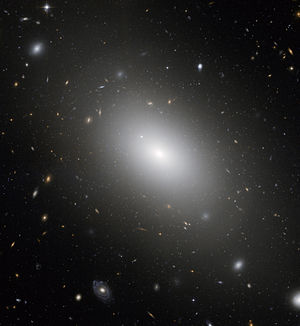NGC 1132
| Galaxy NGC 1132 |
|
|---|---|

|
|
| Photo from the Hubble Space Telescope | |
| AladinLite | |
| Constellation | Eridanus |
|
Position equinox : J2000.0 , epoch : J2000.0 |
|
| Right ascension | 02 h 52 m 51.9 s |
| declination | -01 ° 16 ′ 29 ″ |
| Appearance | |
| Morphological type | E. |
| Brightness (visual) | 12.3 mag |
| Brightness (B-band) | 13.3 mag |
| Angular expansion | 2.5 ′ × 1.3 ′ |
| Position angle | 140 ° |
| Surface brightness | 13.6 mag / arcmin² |
| Physical data | |
| Affiliation | NGC 1132 group |
| Redshift | 0.023133 ± 0.000037 |
| Radial velocity | 6935 ± 11 km / s |
|
Stroke distance v rad / H 0 |
(310 ± 22) x 10 6 ly (95.0 ± 6.6) Mpc |
| history | |
| discovery | John Herschel |
| Discovery date | November 23, 1827 |
| Catalog names | |
| NGC 1132 • UGC 2359 • PGC 10891 • CGCG 389-040 • MCG + 00-08-040 • 2MASX J02525180-0116285 • GC 619 • h 273 • LDCE 202 NED007 | |
NGC 1132 is a giant elliptical galaxy of the Hubble type SB0 in the constellation Eridanus in the southern sky . It is estimated to be 310 million light years from the Milky Way and about 230,000 ly in diameter.
Together with the numerous small dwarf galaxies around them, this very large galaxy forms a very old group that was probably formed by the merging of numerous normal galaxies (see: Fossil Galaxy System ). NGC 1132 is in a huge halo of dark matter . A similar accumulation of dark matter is usually only found in whole groups of up to a hundred galaxies. It has strong X-rays that can be attributed to hot gas. This hot gas is usually only found in large groups of galaxies . NGC 1132's x-ray glow extends over an area roughly ten times the size of the galaxy.
On a Hubble image that was made from observations in 2005 and 2006, numerous old globular clusters can be seen around NGC 1132, which probably earlier belonged to the galaxies that rose in NGC 1132.
In the same area of the sky are u. a. the galaxies NGC 1121 and NGC 1126 .
The object was discovered by John Herschel on November 23, 1827 .
Web links
- SIMBAD Astronomical Database
- Hubble Space Telescope
- Astronews
- Elliptical Galaxy NGC 1132 - Astronomy Picture of the Day February 13, 2008.
